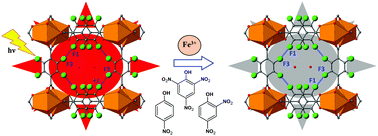Supramolecular assembly of lanthanide-2,3,5,6-tetrafluoroterephthalic acid coordination polymers via fluorine⋯fluorine interactions: a platform for luminescent detection of Fe3+ and nitroaromatic compounds†
Abstract
Observing the significance of fluorine contacts in structural outcomes is an important stride toward crystal engineering of fluorinated coordination polymers and metal–organic frameworks for applications such as luminescence sensing. To this end, two series of structurally isomeric lanthanide coordination polymers formulated as {[Ln(TFTA)1.5(H2O)2]·H2O}n (series 1: Ln = La3+ (1), Ce3+ (2), Pr3+ (3), Nd3+ (4), Sm3+ (5), Eu3+ (6), Gd3+ (7), Tb3+ (8), Dy3+ (9), Ho3+ (10), Er3+ (11), Tm3+ (12) and series 2: Ln = Yb3+ (13) and Lu3+ (14)) were synthesized under slow evaporation conditions with tetrafluoroterephthalic acid (H2TFTA) and characterized by small molecule X-ray crystallography, infrared spectroscopy, elemental and thermogravimetric analysis, as well as differential scanning calorimetry. Compounds in series 1 and 2 consist of finite binuclear Ln-carboxylate SBUs that connect via organic ligands into a 2D framework with sql network topology. F⋯F interactions are involved in self-assembly of each compound, which feature intralayer type I halogen interactions that strengthen with decreasing lanthanide size. Type I F⋯F interactions are also involved in the assembly of the 2D frameworks into 3D supramolecular entities and as predicted, these interactions weaken with the lanthanide contraction. Photophysical studies demonstrate that the TFTA ligand is an efficient sensitizer of Eu3+(5D0) and Tb3+(5D4) luminescence as excitation into ligand bands leads to bright red and green emission respectively, the spectral profiles displaying only metal centred emission bands. Primary and secondary inner filter effects (IFEs) influence the luminescence response of [Eu(TFTA)1.5(H2O)2]·H2O in methanol (6-MeOH) to Fe3+ and nitroaromatic compounds (4-NTP, 2,4-DNP and TNP). While modelling and correction of IFE sheds light on the mechanism of static and dynamic quenching in [Eu(TFTA)1.5(H2O)2]·H2O, it is evident that IFE can be exploited in the use of 6-MeOH as a sensitive, selective, and recyclable luminescence sensor for the detection of Fe3+ ions and explosive nitrophenols.



 Please wait while we load your content...
Please wait while we load your content...